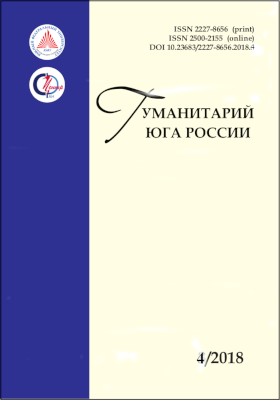Профессиональные риски врачей российских мегаполисов в условиях прекариатизации социально-трудовых отношений
Выражение признательности
Исследование выполнено при поддержке Российского научного фондапроект № 16-18-10306
Для цитирования
Клименко Л. В., Посухова О. Ю. Профессиональные риски врачей российских мегаполисов в условиях прекариатизации социально-трудовых отношений // Гуманитарий Юга России. 2018. Том 7. № 4. С. 91-106. DOI: https://doi.org/10.23683/2227-8656.2018.4.7
Аннотация
В статье на материалах прикладного исследования, проведенного весной 2017 г. среди 870 врачей бюджетных организаций Москвы (468 респондентов) и Казани (402 респондента), рассматриваются показатели прекариатизации труда и профессиональных рисков работников медицинских учреждений. Исследуются оценки врачами их социальной и экономической уязвимости, роста трудовой нагрузки, не сопровождающегося повышением оплаты труда, уровня нестабильности, рисков потери / смены работы.С опорой на эмпирический материал фиксируется высокий уровень прекариатизации труда и профессиональных рисков среди городских докторов. Показывается общая социально-экономическая уязвимость врачей, когда оценка базовых сторон своей жизни (достаток, здоровье, отдых, жилище, жизненные перспективы) является скорее удовлетворительной. Подавляющее большинство опрошенных докторов (от 65 до 80 %) обеспокоены увеличением объема трудовой нагрузки (служебные обязанности, административная нагрузка, отчетность, деятельность, не связанная с должностными обязанностями), которая не сопровождается увеличением оплаты труда. Многие врачи обеспокоены рисками дальнейшего роста трудовой нагрузки (от 63 до 95 % респондентов), потери работы (от 57 до 89 %), сокращения / задержки зарплаты (от 43 до 89 %). На этом фоне московские врачи больше обеспокоены профессиональными рисками, чем казанские доктора.Обосновывается, что прекариатизация социально-трудового положения врачей является очень важным индикатором качества институциональных изменений сферы здравоохранения. Рост трудовой нагрузки, несоответствующая оплата труда, нарушение социально-трудовых прав, неуверенность в профессиональном будущем ведут к тому, что врачи теряют долгосрочные ориентиры, размываются их профессиональные ценности. Реформы в здравоохранении должны не только учитывать экономические и количественные показатели, но и основываться на развитии мотивации, повышении качества человеческого капитала в общественном секторе.
Ключевые слова:
профессиональные риски, врачи, прекариатизация труда, мегаполисы, сфера здравоохранения, трудовая нагрузка, уязвимость
Литература
Александрова О.А. Реформа бюджетных учреждений: мнение пациентов и врачей // Вестник Финансового университета. Гуманитарные науки. 2017. № 3.
Бобков В.Н., Вередюк О.В., Колосова Р.П., Разумова Т.О. Занятость и социальная прекаризация в России: введение в анализ. М. : Теис, 2015.
Зарплаты врачей растут лишь в официальных сводках Росстата // Российская газета. 2017. № 7224 (58).
Клименко Л.В., Посухова О.Ю. Гендерные аспекты прекариатизации труда в российском обществе // Женщина в российском обществе. 2017. № 1.
Клименко Л.В., Посухова О.Ю. Профессиональная идентичность городских учителей в условиях модернизации института образования // Журнал институциональных исследований. 2017. № 9 (2).
Наемный работник в современной России / отв. ред. З.Т. Голенкова. М. : Новый хронограф, 2015.
Присяжнюк Д.И. 2013. Динамика профессионального статуса врачей поликлиник в 2000-х годах // Профессии социального государства. М. : Вариант, ЦСПГИ, 2017.
«Противостояние логик»: врач, пациент и власть в условиях реформирования системы здравоохранения : сводный аналит. отчет // «Левада-центр». Аналитический центр Юрия Левады. 2016. Режим доступа: http://www. levada.ru/cp/wp-content/uploads/2016/05/299_ 1-15_Svodnyj-analiticheskij-otchet.pdf.
Распоряжение Правительства Российской Федерации от 26.11.2012 г. № 2190-р (ред. от 14.09.2015) «Об утверждении Программы поэтапного совершенствования системы оплаты труда в государственных (муниципальных) учреждениях на 2012–2018 годы» Режим доступа: http://www.gks. ru/free_doc/new_site/population/trud/itog_ monitor/zarplata.html.
Шкаратан О.И., Карачаровский В.В., Гасюкова Е.Н. Прекариат: теория и эмпирический анализ (на материалах опросов в России, 1994–2013) // Социологические исследования. 2015. № 12.
Emanuel E.J., Pearson S.D. Physician autonomy and health care reform // Jama. 2012. Т. 307, № 4. Р. 367-368.
Iliffe S. A tale of three disputes: junior doctors against the government 2015-2016 // Soundings. 2017. Т. 64, № 64.
Wu D., Wang Y., Lam K. F., Hesketh T. Health system reforms, violence against doctors and job satisfaction in the medical profession: a cross-sectional survey in Zhejiang Province, Eastern China // BMJ open. 2014. Т. 4, № 12.
Бобков В.Н., Вередюк О.В., Колосова Р.П., Разумова Т.О. Занятость и социальная прекаризация в России: введение в анализ. М. : Теис, 2015.
Зарплаты врачей растут лишь в официальных сводках Росстата // Российская газета. 2017. № 7224 (58).
Клименко Л.В., Посухова О.Ю. Гендерные аспекты прекариатизации труда в российском обществе // Женщина в российском обществе. 2017. № 1.
Клименко Л.В., Посухова О.Ю. Профессиональная идентичность городских учителей в условиях модернизации института образования // Журнал институциональных исследований. 2017. № 9 (2).
Наемный работник в современной России / отв. ред. З.Т. Голенкова. М. : Новый хронограф, 2015.
Присяжнюк Д.И. 2013. Динамика профессионального статуса врачей поликлиник в 2000-х годах // Профессии социального государства. М. : Вариант, ЦСПГИ, 2017.
«Противостояние логик»: врач, пациент и власть в условиях реформирования системы здравоохранения : сводный аналит. отчет // «Левада-центр». Аналитический центр Юрия Левады. 2016. Режим доступа: http://www. levada.ru/cp/wp-content/uploads/2016/05/299_ 1-15_Svodnyj-analiticheskij-otchet.pdf.
Распоряжение Правительства Российской Федерации от 26.11.2012 г. № 2190-р (ред. от 14.09.2015) «Об утверждении Программы поэтапного совершенствования системы оплаты труда в государственных (муниципальных) учреждениях на 2012–2018 годы» Режим доступа: http://www.gks. ru/free_doc/new_site/population/trud/itog_ monitor/zarplata.html.
Шкаратан О.И., Карачаровский В.В., Гасюкова Е.Н. Прекариат: теория и эмпирический анализ (на материалах опросов в России, 1994–2013) // Социологические исследования. 2015. № 12.
Emanuel E.J., Pearson S.D. Physician autonomy and health care reform // Jama. 2012. Т. 307, № 4. Р. 367-368.
Iliffe S. A tale of three disputes: junior doctors against the government 2015-2016 // Soundings. 2017. Т. 64, № 64.
Wu D., Wang Y., Lam K. F., Hesketh T. Health system reforms, violence against doctors and job satisfaction in the medical profession: a cross-sectional survey in Zhejiang Province, Eastern China // BMJ open. 2014. Т. 4, № 12.
Форматы цитирования
Другие форматы цитирования:
APA
Клименко, Л. В., & Посухова, О. Ю. (2018). Профессиональные риски врачей российских мегаполисов в условиях прекариатизации социально-трудовых отношений. Гуманитарий Юга России, 7(4), 91-106. https://doi.org/10.23683/2227-8656.2018.4.7
Раздел
СОЦИАЛЬНАЯ СТРУКТУРА И СОЦИАЛЬНЫЕ ИНСТИТУТЫ В СОВРЕМЕННОМ ОБЩЕСТВЕ






